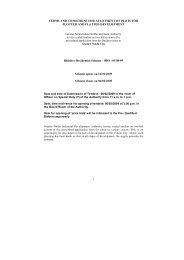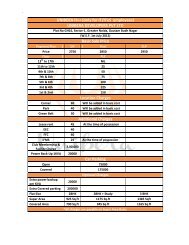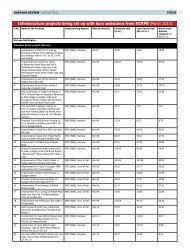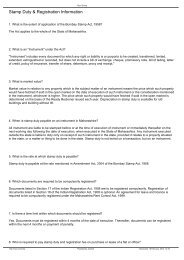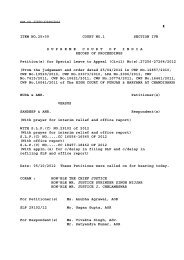eLegalix - Allahabad High Court Judgment Information System ...
eLegalix - Allahabad High Court Judgment Information System ...
eLegalix - Allahabad High Court Judgment Information System ...
You also want an ePaper? Increase the reach of your titles
YUMPU automatically turns print PDFs into web optimized ePapers that Google loves.
JUDGMENT/ORDER IN - WRIT - C No. 37443 of 2011 at <strong>Allahabad</strong> Dated-21.10....http://elegalix.allahabadhighcourt.in/elegalix/WebShow<strong>Judgment</strong>.doPage 161 of 19710/21/2011from all incumbrances. It is, therefore, clear that taking of possession within the meaning of section 16 or 17(1)means taking of possession on the spot. It is neither a possession on paper nor a "symbolical" possession asgenerally understood in Civil Law. But the question is what is the mode of taking possession? The Act is silent onthe point. Unless possession is taken by the written agreement of the party concerned the mode of takingpossession obviously would be for the authority to go upon the land and to do some act which would indicate thatthe authority has taken possession of the land. It may be in the form of a declaration by beat of drum or otherwiseor by hanging a written declaration on the spot that the authority 10 SC 75-18 has taken possession of the land.The presence of the owner or the occupant of the land to effectuate the taking, of possession is not necessary.No further notice beyond that under section 9(1) of the act: is required. When possession has been taken, theowner or the occupant of the land is dispossessed. Once possession has been taken the land vests in theGovernment."In paragraph 28 it was further observed that how such possession may be taken, would depend on the nature ofthe land and there can be no hard and fast rule laying down what acts would be necessary to constitute taking apossession of the land. In Balmokand Khatri, Educational and Industrial Trust v. State of Punjab 1996(4) SCC212, Apex <strong>Court</strong> observed that normal mode of taking possession is drafting the Panchnama in the presence ofPanch as taking possession and giving to the beneficiaries following were laid down in paragraph 4:"4. It is seen that the entire gamut of the acquisition proceedings stood completed by 17-4-1976 by which datepossession of the land had been taken. No doubt, Shri Parekh has contended that the appellant still retained theirpossession. It is now well-settled legal position that it is difficult to take physical possession of the land undercompulsory acquisition. The normal mode of taking possession is drafting the Panchanama in the presence ofPanchas and taking possession and giving delivery to the beneficiaries is the accepted mode of takingpossession of the land. Subsequent thereto, the retention of possession would tantamount only to illegal orunlawful possession."In Narmada Bachao Andolan's case (supra) Apex <strong>Court</strong> had occasion to consider the question of issue of takingpossession. The manner of taking possession of land in Narmada Bachao Andolan, Apex <strong>Court</strong> held that in casethe land is fallow and barren and does not have any structure or crop symbolic position may meet the requirementof law. However, this will not be a position in case crop is standing or a Kuccha or Pucca structure has beenraised on such land following was laid down in paragraph 124.124. In view of the above, law on the issue can be summarized to the effect that no strait-jacket formula can belaid down for taking the possession of the land for the purpose of Sections 16 and 17 of the Act 1894. It woulddepend upon the facts of an individual case. In case the land is fallow and barren and does not have any structureor crop on it, symbolic possession may meet the requirement of law. However, this would not be the position incase crop is standing on the land or a kachha or pacca structure has been raised on such land. In that case,actual physical possession is required to be taken. There may be a case where the acquiring authority is inpossession of the land, as the same has already been requisitioned under any law or the property is inpossession of a tenant, in such a case symbolic possession qua the tenure holder would be sufficient.In Banda Development Authority's case (supra) the Apex court again considered manner of taking possessionand after considering earlier judgment following principle was laid down in paragraph 37 which is quoted asbelow:37. The principles which can be culled out from the above noted judgments are:i) No hard and fast rule can be laid down as to what act would constitute taking of possession of the acquiredland.ii) If the acquired land is vacant, the act of the State authority concerned to go to the spot and prepare apanchnama will ordinarily be treated as sufficient to constitute taking of possession.iii)If crop is standing on the acquired land or building/structure exists, mere going on the spot by the authorityconcerned will, by itself, be not sufficient for taking possession. Ordinarily, in such cases, the authority concernedwill have to give notice to the occupier of the building/structure or the person who has cultivated the land and takepossession in the presence of independent witnesses and get their signatures on the panchnama. Of course,refusal of the owner of the land or building/structure may not lead to an inference that the possession of theacquired land has not been taken.iv)If the acquisition is of a large tract of land, it may not be possible for the acquiring/designated authority to take





